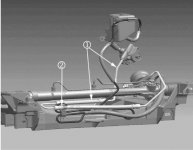carbuff
Active member
Hey Guys, need your help please.
Can anyone help? I do not have a shop (service) manual for this car. My Power steering fluid is dark Coke colored (apparently common), and the system needs a PS flush.
Anyone have the EXACT DETAILED procedure for doing one on a C6? Can anyone post the procedure outlined in the service manual?
The way I generally understand it from reading the internet as it applies to other cars, is to:
1. disconnect the return hose to the reservoir. But which of the 2 hoses is that on the C6? The fat one or the skinny one? Looks like the skinny one in the diagram?
And how do you do this? Presume you need to drain the reservoir first. But then you are sucking air into the system?
2. Plug inlet hole in reservoir. Does anyone know what to plug it with, and what diameter this needs to be? Once you disconnect it, you do not have time to rummage around for the right size plug, since fluid is dripping everywhere at that point.
Then fill the reservoir with fresh fluid. How much fluid will I need to do a flush. Someone said on the internet that it could take up to a gallon!!
3. Put the return hose into a bottle to catch dirty fluid.
4. Lift up entire front end of the car.
5. Start car, turn wheels from side to side. Keep topping up fluid in reservoir while doing so, as not to suck in air.
6. Stop when fluid is running clear.
7. Then somehow reconnect the return hose to reservoir. But how do you do this when the reservoir is still full of fluid, without making a holy mess? Do you need to drain the reservoir again first?
Is it worth paying the dealer $100 to do this service, given the fluids cost less than $10?
Has anyone done this flush themselves? Your help is much appreciated. Thanks!
Can anyone help? I do not have a shop (service) manual for this car. My Power steering fluid is dark Coke colored (apparently common), and the system needs a PS flush.
Anyone have the EXACT DETAILED procedure for doing one on a C6? Can anyone post the procedure outlined in the service manual?
The way I generally understand it from reading the internet as it applies to other cars, is to:
1. disconnect the return hose to the reservoir. But which of the 2 hoses is that on the C6? The fat one or the skinny one? Looks like the skinny one in the diagram?
And how do you do this? Presume you need to drain the reservoir first. But then you are sucking air into the system?
2. Plug inlet hole in reservoir. Does anyone know what to plug it with, and what diameter this needs to be? Once you disconnect it, you do not have time to rummage around for the right size plug, since fluid is dripping everywhere at that point.
Then fill the reservoir with fresh fluid. How much fluid will I need to do a flush. Someone said on the internet that it could take up to a gallon!!
3. Put the return hose into a bottle to catch dirty fluid.
4. Lift up entire front end of the car.
5. Start car, turn wheels from side to side. Keep topping up fluid in reservoir while doing so, as not to suck in air.
6. Stop when fluid is running clear.
7. Then somehow reconnect the return hose to reservoir. But how do you do this when the reservoir is still full of fluid, without making a holy mess? Do you need to drain the reservoir again first?
Is it worth paying the dealer $100 to do this service, given the fluids cost less than $10?
Has anyone done this flush themselves? Your help is much appreciated. Thanks!


 ad and previously posted incorrect info.
ad and previously posted incorrect info. 


